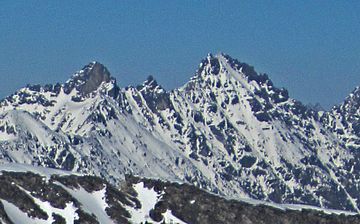Kimtah Peak facts for kids
Quick facts for kids Kimtah Peak |
|
|---|---|

Cosho Peak (left) and Kimtah Peak (right)
|
|
| Highest point | |
| Elevation | 8,600+ ft (2,620+ m) |
| Prominence | 1,040 ft (320 m) |
| Geography | |
| Location | Skagit County, Washington, U.S. |
| Parent range | Cascade Range |
| Topo map | USGS Mount Logan |
Kimtah Peak is a tall mountain in North Cascades National Park in Washington, USA. It stands about 8,600 feet (2,621 meters) high. This peak is part of a rocky ridge called Jagged Edge. You can find the Kimtah Glacier on its northwest side and the Katsuk Glacier to the northeast.
Weather and Climate
Kimtah Peak is located in a special climate zone called the marine west coast climate. This means it gets a lot of moisture from the Pacific Ocean. Most of the weather systems, like big clouds and storms, start over the Pacific. They then travel east towards the Cascade Mountains.
When these weather systems reach the tall peaks of the Cascades, the mountains force the air to rise. As the air goes higher, it cools down and drops its moisture. This moisture falls as rain or snow onto the mountains. This process is called orographic lift. Because of this, the western side of the North Cascades gets a lot of rain and snow, especially in winter.
During winter, the weather is often cloudy. But in summer, high-pressure systems over the Pacific Ocean become stronger. This often leads to clear skies and sunny weather.
How the Mountains Formed
The North Cascades area has some of the most rugged and dramatic landscapes in the Cascade Range. You can see jagged peaks, sharp ridges, deep valleys carved by glaciers, and tall spires made of granite. These amazing features were created by geological events that happened millions of years ago. These events also led to big changes in elevation and different climates across the Cascade Range.
The story of the Cascade Mountains began millions of years ago, during a time called the late Eocene Epoch. At that time, the North American Plate (a huge piece of Earth's crust) was slowly moving over the Pacific Plate. This movement caused a lot of volcanic activity.
Also, small pieces of Earth's crust, called terranes, crashed into the North American continent. These collisions helped build the North Cascades about 50 million years ago.
Later, during the Pleistocene period (which started over two million years ago), huge sheets of ice called glaciers moved across the land. These glaciers advanced and retreated many times. As they moved, they scraped and carved the landscape, leaving behind piles of rock. The river valleys in the area are shaped like a "U" because of these glaciers.
So, the tall peaks and deep valleys of the North Cascades were mainly formed by two powerful processes: the land being pushed up (called uplift) and breaking along cracks (called faulting), combined with the powerful carving action of glaciers.



